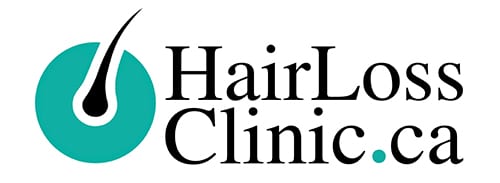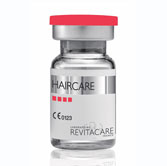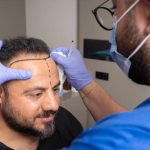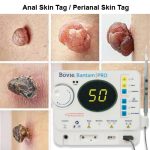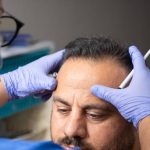Table of Contents
HAIR LOSS MEN EXPERIENCE AND RECOMMENDED TREATMENTS

HAIR LOSS MEN CLINICS IN TORONTO AND RICHMOND HILL
Hair loss can be emotionally and psychologically devastating for some men and their self-esteem. Male pattern hair loss accounts for 95% of all hair loss conditions in men. By 35, roughly two-thirds of all men will have noticeable hair loss. By 50, approximately 85 percent of men will have significant hair loss. Men can also begin to lose their hair in their teens and twenties. In their twenties, approximately 20% of men experience hair loss. Our hair loss men’s clinic treats many men suffering from androgenetic alopecia.
Approximately 100,000 hairs are found on the average scalp. On an average day, men can lose 50 to 100 hairs. However, thinning hair becomes more visible as more hairs are shed each day. Fortunately, there are treatments available for most male hair loss issues. Some hair loss conditions are only temporary, and the hairs will usually regrow once the problem is resolved. Other types of hair loss, such as male pattern baldness, need treatment to maintain and stimulate hair growth.
WHAT IS MALE PATTERN HAIR LOSS
Male pattern hair loss (MPHL), male pattern baldness (MPB), or male pattern alopecia (MPA) is a type of androgenetic alopecia that affects men. Male pattern hair loss is thought to be caused by a combination of genetics and Androgens (most notably dihydrotestosterone/DHT), which act on genetically predisposed hair follicles to cause genetic hair loss.
The frontal hairline recedes into the back of the scalp in male pattern hair loss, resembling a horseshoe. The hairs on the side and back of most men’s heads are unaffected.
Hair miniaturization is also used to describe hair loss caused by androgens. The size of the affected hair follicles decreases, decreasing the diameter of the hairs they produce. As these hair follicles shrink over time, so do the hairs that emerge from them until only a few visible hairs remain. The exact substance that “miniaturizes” the hair follicles is unknown; however, it is theorized that DHT sensitivity causes a collagen build-up around the hair follicle, causing it to shrink.
A person is more likely to inherit hair loss conditions like those of the family member whose hair characteristics he most closely resembles in terms of colour, hair type (coarseness or fineness), and hair distribution.
Hair loss is polygenic, meaning many genes are involved in the condition’s development. They can be passed down from either the father’s or mother’s side. The higher the percentage of close family members who have androgenetic hair loss, the more likely a person is to develop the condition.
TYPES OF HAIR LOSS MEN EXPERIENCE
The most common type of hair loss men experience is androgenetic hair loss. But there are other less common hair loss conditions that men can have as well.
• Male Pattern Hair Loss (Androgenic Alopecia): Male pattern hair loss is an androgenetic alopecia affecting men. Genetic Hair Loss is initiated by the action of androgens (mainly dihydrotestosterone/DHT) upon the genetically predisposed hair follicle.
• Alopecia Totalis: Alopecia totalis is characterized by hair loss to the scalp. Hair regrowth can be expected as the hair follicles are not destroyed. It is an advanced form of Alopecias Areata, the more common of the two.
• Alopecia Universalis: The advanced form of alopecia Universalis is an autoimmune condition that causes complete hair loss throughout the scalp and body. Statistics show that only 1 in 4000 people get this type of male hair loss. The number of people with the advanced form ranges from 7% to 25% of the population.
• Telogen Effluvium: Telogen effluvium is a temporary hair loss condition that can affect both men and women. When your body goes through something traumatic, it can change the growth cycles of the hair. About 90% of your hairs are in the anagen phase (growth phase) or transitional phase (catagen), but any trauma to your body could cause it all to shift to the resting phase (telogen)
• Trichotillomania (Hair-pulling disorder): Trichotillomania is a hair-pulling disorder that mainly causes hair loss in younger girls, although males can also have this condition. Hair pulling can occur in any region of the body, but the primary affected area is the scalp. The urge to pull hair is a mental disorder, and the best treatment is cognitive-behavioural therapy.
• Alopecia Areata: With alopecia areata, bald patches of your scalp are more visible. It is an auto-immune disorder that can affect both men and women. The most common form of treatment is the use of corticosteroids. These are anti-inflammatory drugs that can suppress the immune system.
• Cicatricial Alopecia (scarring alopecia): Cicatricial alopecia is a hair loss condition caused by a group of rare disorders that destroy the hair follicles and replace them with scar tissue. It is seen in about 7% of adult men and women but rarely in children. The scarring is not seen on the scalp but underneath the skin in the fractured hair follicles. The skin looks bald, smooth, and shiny in the areas affected. Also, pores are absent because of the complete loss of hair follicles.
TREATMENTS FOR MALE PATTERN HAIR LOSS
• Prescription and OTC medication: There are two main medications for treating male pattern baldness. These are Minoxidil (Rogaine) and Finasteride (Propecia, Proscar). It may take up to a year to see results from minoxidil and finasteride, and you will need to continue taking them to maintain the benefits.
• Hair transplants: The two most common hair transplant procedures are follicular unit transplantation and follicular unit extraction. Remember that both hair transplant procedures are considered surgery, which can be invasive, costly and painful. There are also risks, such as infections and scarring. You may also need to undergo multiple hair transplant procedures to achieve the desired results.
• Laser treatments: Laser treatment is thought to reduce inflammation in follicles that prevent them from regrowing. Although there are only a few studies to back up their effectiveness in treating hair loss, a 2016 review found that when used to treat male pattern hair loss, low-level laser therapy (LLLT) is both safe and very effective.
• Scalp massages: Massages not only feel great for the body but may also aid hair loss. The hair follicles are stimulated by massaging the scalp. Healthy Japanese males who underwent 4 minutes of scalp massage each day for 24 weeks had thicker hair at the end of the trial, according to a small 2016 study. According to a 2019 study, scalp massages relate to self-perceived improvements in hair density.
• Scalp Micropigmentation (SMP): Scalp micropigmentation, often called SMP, is an advanced cosmetic hair loss treatment that uses a tattoo method to create small dots the size of hair follicles. These dots are designed to replicate the appearance of natural hair where you are experiencing loss. Although often called a hair tattoo, SMP is nothing like a regular tattoo. SMP® requires the technician to apply the specialized technique using a multitude of different needle sizes, penetration depths, angles, pigment colours and distribution rates depending on the specific area of the scalp being treated at the time, the skin tone of the individual and the desired final appearance.
To Book your in-office consultation, please contact us at 647-492-9093 or visit our website to book a free professional consultation here: https://hairlossclinic.ca/trichology-assessment-form/
Comments are closed.
